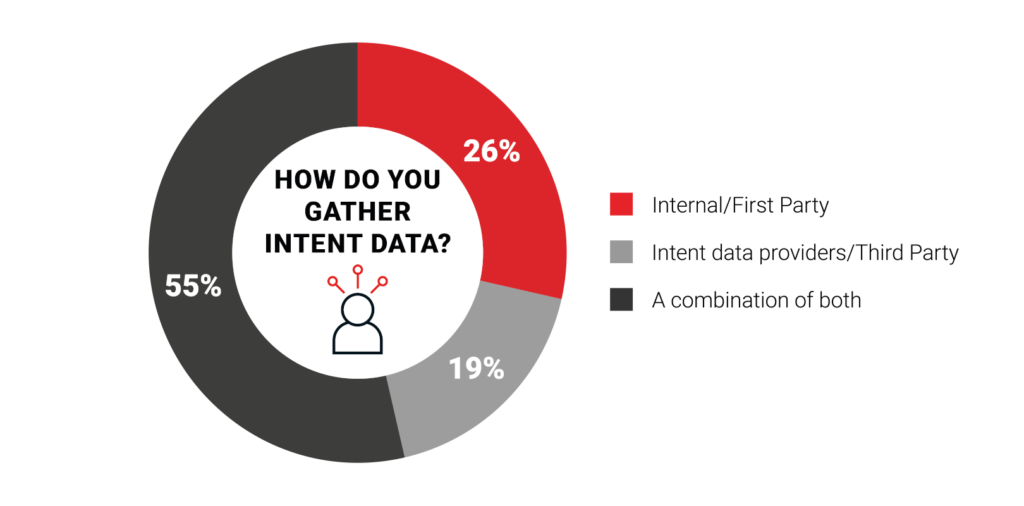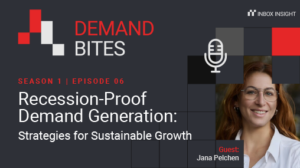With 99% of marketers leveraging intent data to some extent within their marketing strategy, it’s evident that intent data is an invaluable tool for demand generation. Businesses can utilize it to grow their lead pipeline and discover sales opportunities that were previously hidden.
When it comes to deciding where to source your intent data, it is worth considering that first-party data, second and third-party data all give different outlooks, provide different benefits and have their own challenges.
We spoke to 200 senior marketing specialists in large companies of 500+ employees across multiple industries to see what they had to say – which is better for demand generation, first-party, second-party or third-party intent data?
How are B2B marketers sourcing intent data?
According to our latest research, 26% of B2B marketers utilize first-party data, 19% use third-party only, and 55% (the majority) harness a combination of both in their demand generation strategies. Of those using a combination of both, 75% of responders rely on first-party data more than third-party data.

First-party intent data
First party data can be any of the following:
- Internal searches and keyword queries
- Website cookies and behaviour flow tracking
- Email tracking and nurture workflows
- Social media listening tools
- Any interactions with customers
The reason why so many marketers rely on first-party data is having a direct view of your audience – the people who are already interested in what you have to offer.
With 1st party data, the benefits include saving money through in-house data collection, full control over the data, the ability to tailor topic taxonomies, and the ability to drill down into individual buyers within an account.
In short, first-party intent data is easily accessible, highly valuable, with little-to-no significant additional costs incurred. By combining buyer intent algorithms with your own company records and continually updating them, you can tap into data you already own to see which accounts are in-market to purchase imminently. Not only does this save money in external data spend, but it helps you get to know your buyers and map their behavior effectively.
With this in mind, we recommend that all B2B marketing teams should leverage their own first-party intent data and incorporate this into their marketing strategies.
Second-party intent data
Second-party intent data is essentially someone else’s first-party data. This type of data provides an opportunity to gain customer insights from a different perspective, often from partners or affiliates. These insights are invaluable as they offer a fresh view and understanding of customer behavior that can fuel innovative marketing strategies.
One of the key benefits of second-party data is the opportunity to access a wider audience base. By leveraging second-party data, you have a chance to reach potential customers that are beyond your immediate audience. This can significantly increase your market exposure and expand your reach.
Another benefit is the depth of data. While first-party intent data provides you with direct insights about your customers, second-party intent data can provide you with a broader view of market trends, patterns in customer behavior, and potential opportunities. Collaborating with partners or affiliates to access this data can lead to a more comprehensive understanding of your market.
Second-party data also has the ability to provide a high level of accuracy. While it might not be as precise as 1st party intent data, it is typically more accurate than third-party data as it comes from a trusted source. This makes it a reliable source for businesses looking to make informed decisions.
In a nutshell, while first-party intent data remains a priority, second-party intent data can play a pivotal role in enhancing your marketing efforts, broadening your customer reach, and providing you with deeper market insights. It’s a data goldmine waiting to be tapped into.
Third-party intent data
Third-party intent data comprises of insights gathered across any digital touchpoints external to your organization – for example, all websites, content platforms and social media channels.
Despite 3rd party intent data being less relied upon as the main source of insight, it is arguable that marketers are missing a trick when it comes to utilizing intent data.
When utilized effectively, third-party intent data can provide a whole range of benefits that first-party data might not have the ability to bring.
For example, it can harvest interest earlier in the buyer journey, enabling Sales and Marketing teams to adapt their communications with this account in order to encourage engagement. Third-party intent data also marries well with third-party account-based marketing activities, whereby external companies can utilize intent alongside targeted content amplification to better reach and engage “in-market” prospects.
Finally, 3rd party intent data offers scale. Whilst 1st party is fantastic for bringing attention to highly-engaged, pre-existing accounts, third-party can help marketers to access many more new prospects and encourage them into your pipeline in a seamless, efficient fashion.
A combined approach for effective demand generation
In order to get a more complete picture of the market, your audience and their behaviors, a combined approach is often ideal – and many B2B marketers understand this, with 55% agreeing that they use both within their strategy.
Whilst our latest research suggests that 1st party intent data is more relied upon, with more marketers incorporating it into their strategy, one of the biggest challenges faced by said marketers is having the ability to action on intent data insights. Is this a sign that businesses are unaware of how strong first party data can support a third party data strategy to drive additional opportunities?
By utilizing a combined approach, you get full visibility into your current prospects and customers and how they engage with your brand across your own channels – as well as a sneak peak into engagement across all external sites, providing the ability to use advanced targeting techniques to attract and engage new prospects. 3rd party intent allows you to access audiences who are in-market who are not currently engaging with your organization.

It’s similarly important to point out that no matter which approach was taken by marketers, 99% revealed resounding success from their marketing campaigns, attesting to increased ROI, improved conversion rates, or both.
Only 1% said that it was too early to tell if intent data had been beneficial for their performance, showing that any use of intent data, whether it be first or third party, is able to bring results.
In addition to the 99% who have seen an improvement to their sales and bottom line, similarly, 98% of our survey respondents confirm that using intent signals is something that is fundamental to their strategy. 41% of marketers even consider intent data to be at the heart of what they do.

Final thoughts
Whether you decide to focus your marketing efforts on using internal data, external sources, or a mixture of both, the key is to use the data in the right context. Understand the limits of each, apply it in the right way, and you can make intent data meaningful and actionable for your B2B marketing and sales teams. By having a clear data strategy, setting realistic goals, and manipulating intent to fill in those knowledge gaps, you can open up a world of information that you never had before.






